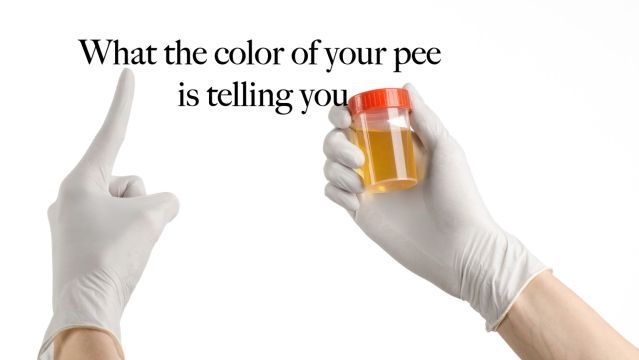
Sometimes it’s surprising how unexpected simple things can tell us a lot about our state of health. Take for example the color of urine — color changes in pee can be an early indicator of potential health problems. How often do you sneak a peek at your urine? If you are like most people, you probably don’t bother, right?
During your lifetime, your kidneys will work very hard to filter over one million gallons of water. Urine is about 95 percent water and 5 percent uric acid, the stuff that your body does not need — including minerals, enzymes and salts that are dangerous if they accumulate in your body.
Urine can fluctuate in color and odor depending on what you are eating and drinking, how active you are, the time of day, or what supplements you are taking. However, urine color and odor can also be an indication of something more serious.
Would you have ever thought that great things could be learned from your pee? Urine should be pale yellow or clear — not glow-in-the-dark yellow or dark yellow. It should not be cloudy or have a knock-you-over odor, unless you have been eating asparagus!
Anything apart from clear and odorless could be a sign of trouble.
Urine is made up of excess water and waste that your kidneys have filtered. Urochrome, a pigment found in blood, gives urine its natural light yellow tone. Depending on how hydrated you are, you urine color can fluctuate from clear to darker yellow or even orange-tinted.
Here is a quick pee primer to fill you in on what you should look for and what your urine may be telling you.
Super clear or transparent
Yep, there is such a thing as urine that is too clear. If your urine is super clear, it may mean you are drinking too many fluids. Be careful not to over-hydrate. The best rule of thumb is to aim for half of your body weight in ounces each day.
This means, if your weight is 120 pounds, you should be drinking 60 ounces of water per day. More serious conditions, such as acute viral hepatitis or cirrhosis, can also cause your pee to turn very clear. However, you will also have other symptoms, such as skin yellowing, nausea or vomiting with these conditions. Pale straw coloring to a transparent yellow hue means you are healthy and receiving a proper amount of hydration.
Dark yellow colored
Urine that is dark yellow in color is still considered within a normal range for healthy individuals. However, it also likely indicates you may not be as hydrated as you should be.
Honey or amber colored
These darker, orange hues are usually a good indicator that you are becoming dehydrated. It is best to increase your water intake and then check to see if the color returns to a normal yellow range. When combined with pale-colored stools, orange urine may be an indication of liver problems.
Neon yellow colored
Glowing yellow urine may be the result of excess vitamins that are not being absorbed by your body. It is best to eat a diet loaded with whole foods and stick to whole food supplements that your body can absorb.
Light to dark orange colored
This is a somewhat ambiguous color because it could mean something or nothing. This tint can be caused from food dyes, dehydration, or actual health problems with your bile duct or liver. It is always best to check with a physician.
Green or blue colored
This is most likely going to be caused from artificial coloring in something that you ate. However, it could be from a bacterial infection in the urinary tract or the sign of a rare genetic disorder. Consult with a physician to rule out health problems.
Brown or cola-colored
This color is a possible sign of serious dehydration or even possible liver disease. Immediately increase your water intake and check to see if the color lightens. If this darkened coloration persists, you should follow up with your physician.
Light pink to darker red colored
This is hard to interpret. Many foods can cause urine discoloration, such as beets and blueberries. Medications can also contain dyes and compounds that can change the color of your urine. However, it might indicate the presence of blood in the urine, but many times blood in the urine is not visible to the naked eye. There are a number of possible causes that would lead to blood in the urine, like kidney disease, urinary tract infections, and prostate issues. It is always best to consult with your physician to be sure.
Other considerations
Besides color, it is a good idea to pay careful attention to other urine abnormalities including the following:
Cloudy urine
If you are having low back pain, lower abdomen pain, or urinary urgency combined with cloudy urine, see a physician. Cloudy urine may also be the result of kidney stones, generally accompanied by great pain.
Fizzy or foamy urine
Besides the color, it’s important to take notice if your urine appears to be fizzy or foamy. If this only happens on rare occasions then it is likely just a benign cause. If it is occurring regularly, it may be indicating possible high levels of protein in the urine. When in doubt, it is best to get it checked out.
A note about odor
Normal urine should not have a strong odor, but there are also many substances that can alter the way your pee smells. Urine is the reflection of what is going on inside of your body and contains many metabolic by-products and compounds. Some dogs are even able to “smell cancer” in humans.
If your urine has a very pungent aroma, like ammonia, it could be an indication of a urinary tract infection, urinary stones, or a sign of dehydration. Because dehydration causes urine to become concentrated, it will have a stronger than usual odor. According to MDHealth.com, menopause, some sexually transmitted diseases, and certain metabolic conditions can also increase the ammonia smell.
 Other reasons for a change in urine odor include the following:
Other reasons for a change in urine odor include the following:
- Medications and supplements — some may change the color of urine.
- Diet — certain foods, such as asparagus, cause urine to smell foul.
- Diabetes — can cause urine to smell fruity or yeasty.
The most important thing to remember when checking your urine color is that it can change to a myriad of colors due to a number of factors. Just knowing what normal urine should look and smell like provides a useful measuring tool. See a physician if your urine changes color and the color persists or is accompanied by other symptoms.
Though it may sound a little strange, paying attention to the color of your urine may be a warning sign to catch early health problems. Isn’t it worth a quick sneak peek in the toilet bowl to make sure everything is okay?
—Susan Patterson
Susan is the Content Director at The Alternative Daily, a Certified Health Coach, Certified Metabolic Typing Advisor and Master Gardener. With an extensive knowledge of whole foods and wellness, Susan enjoys educating others on how to live healthy and sustainable lives. She presently lives off grid in the middle of the New Mexican high desert with her three children and numerous animals.
Sources:
http://health.clevelandclinic.org/2013/10/what-the-color-of-your-urine-says-about-you-infographic
http://www.webmd.com/urinary-incontinence-oab/features/the-truth-about-urine
http://www.bodybuilding.com/fun/50-shades-of-yellow-what-color-should-your-pee-be.html
http://www.mayoclinic.org/diseases-conditions/urine-color/basics/definition/con-20032831

